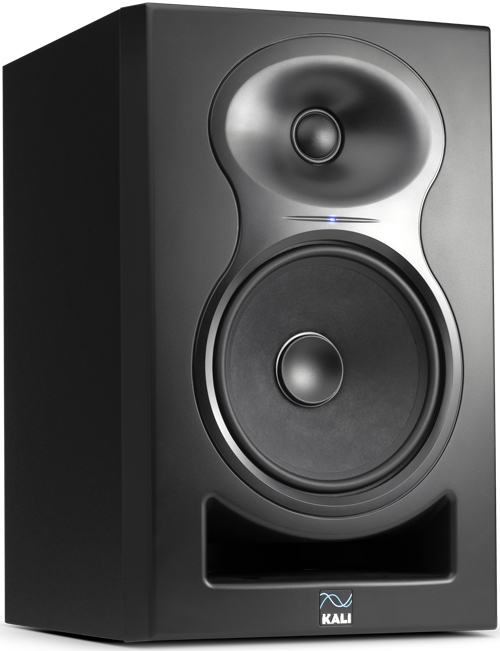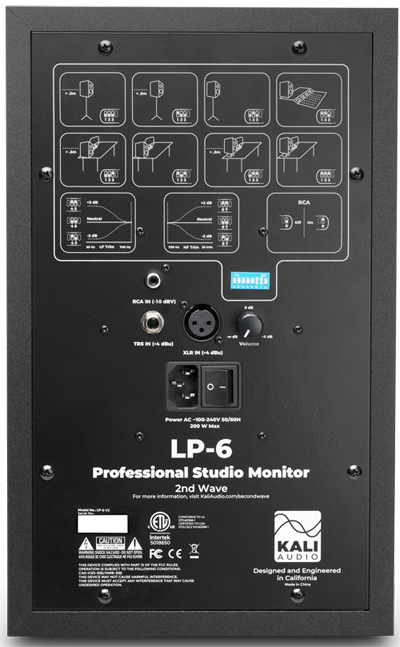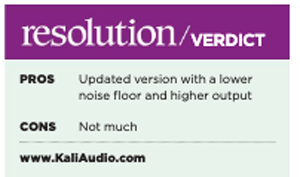

Music Connection Magazine Reviews Mix Magazine Reviews
Sign Up For A Free Trial Subscription To Resolution Magazine!
 |
| Kali Audio LP-6 2nd Wave |
Kali Audio's 2nd Wave LP-Series Monitors are upgraded versions of their best-selling 2-way LP-Series of studio monitors first launched in 2018. There are just two models in the line: the LP-6, a 6.5-Inch monitor (reviewed here) and the LP-8, with an 8-Inch woofer.
I've found all the Kali Audio monitors to sound marvelous especially considering their low retail price point(s)--the LP-6 is less than $199 US MSRP each. The LP-6 measures: height is 14.125-inches (35.9 cm), width 8.75-inches (22.2 cm), and 10.25-inches (26 cm) deep. Their compact size, great sound and pricing making them popular for new, professional surround/ATMOS monitoring setups both at home and in the studio. The LP-6s will work as rear surround or object monitors with the larger LP-8 models or the Kali Audio IN-8 three-ways making up the L-C-R monitors.
LP, named after Lone Pine, a hiker's rendezvous point in California's Eastern Sierra Mountains, was Kali Audio's first monitor line and the 2nd Wave update covers both user suggestions as well has big improvements in performance and sound.
What's In The Box?
The 6.5-inch woofer has a two-layer voice coil, large ceramic magnet and a pole vent to reduce noise at high excursions when producing low frequencies. The 1-inch soft dome tweeter uses a 3-D imaging waveguide that, along with the woofer, produce a wide and coherent imaging.
With the 2nd Wave models, there is a 12dB lower self-noise and 3dB higher output. The LP-6 is designed to have a continuous output of 85dB SPL at a distance of 2.9-meters with 20dB of headroom.
In addition, the front-firing port tube works well in my small studio even if they are placed close to or right against my front wall. Port turbulence--or air leaving at different speeds from the port usually causes a "chuffing" noise is minimized because of the aerodynamically contoured and sculpted shape of the port. You can spot the 2nd Wave monitors easily because the new lighter weight woofers use less material and are a natural matte black instead of the glossy finish of the original LP-6 monitors.
 |
| Kali Audio LP-6 Rear Panel Controls |
The LP-6 uses two Class-D amplifiers; there is 40-watts for the woofer and another 40-watt amp for the tweeter. The crossover is 1500-Hz and the monitor's frequency range is specified at 47Hz to 21kHz +/- 3dB. As like most powered monitors, a limiter circuit protects the speaker drivers from excessive input voltage audio levels. This feature is has been improved with the LP-6s power LED flashing red immediately when overdriven but all is OK--just turn it down!
The Boundary EQ settings are accessible on the rear panel along with a quick reference guide printed directly onto the speaker's rear metal panel heat sink itself. DSP is also improved and there is a boundary EQ setting for using LP-6 on desks with monitor stands.
Not a room EQ, Boundary EQ fixes typical problems associated with locating the monitor directly on desktops, close or far from the front wall of the studio, or right on top of your console's bridge, or just freestanding on stands more than 0.5-meters from the front wall--the ideal position for these monitors. These different scenarios are depicted graphically on the real panel with DIP-switch positions to correct them--all a brilliant idea.
In the Studio
I connected the LP-6s as my alternate monitoring system. I ran them flat without any boundary EQ and neutral HF and LF trim settings. I like using them at very low volume levels. They have good bass and are truer than my Yamaha NS-10ms--they are not as "pushed out" in the mid-range as the NS-10m and are more full-range.
 |
The LP-6s are not overly bright but if you are in an overly absorptive space and feel the high frequencies are dulled, you can engage the rear panel HF Trim DIP switch #6 for a +2dB-shelving boost from 700Hz and above. My mix room is acoustically treated with bass trapping and a lot of absorption and I used this setting in addition to having a reflective hardwood floor under my listening position.
There is a volume control on the back of the LP-6 with a center detent that makes adjusting the volume to match your main monitors if it cannot be done on your monitor controller. I'm using a Cranesong Avocet II monitor controller so I didn't need take the LP-6 controls off their detent.
I found the new Kali LP-6s perfect for close, nearfield mixing without a sub-woofer. I put them on Sound Anchor floor stands and on either side of my two 29-inch LG screens (one above the other). The front of the monitors are 1-meter from the front wall behind them, angled inward toward the listening position, and set up in the exact centerline of my mix room that is 2.8 meters wide and 2.5-m in height. The LP-6s are 115 cm on center left and right and 130-cm from the floor and aimed downward using a pair of IsoAcoustic Aperta 200 speaker stands.
I liked that it is easy to obtain a solid stereo image with these new models and they have a super quiet noise floor. Bass is good with the bottom octave well heard. I think the Kali Audio LP-6s 2nd Wave monitors are an excellent choice for a set of great sounding powered monitors! For small editing/mixing suites for stereo or surround/Atmos monitoring, they are big winners! Highly recommended!
|
|
|